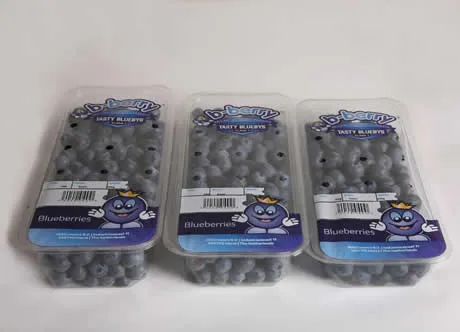Consumers prefer to buy blueberries if they have a nice color and are presented, undamaged, in the store. The correct temperature and packaging are needed. This is to guarantee that the berries remain tasty and nice looking. abbGrowers is a Dutch blueberry grower, sorter and packer. They are convinced that PET packaging prevents a lot of wastage. The company thinks it is a responsible choice.

"Blueberries are a fruit that stores well if it remains well refrigerated. The temperature has to be 2 Degrees Celsius. The correct temperature is critical during the entire process - from harvesting to sorting, packaging, and transporting the berries to the client," says a representative from abbGrowers.
"Packing these berries in a plastic container does, however, raise questions. Is there no alternative? Because environmentally conscious consumers want to move away from plastic. Packaging blueberries is not a choice. It is not an apple that you can simply put, loose, in the store shelf."
"Blueberries are fragile and are, not for no reason, classified as a soft fruit. Packaging is designed to protect the product against outside influences. In this way, the product reaches the consumer undamaged. If we use the incorrect packaging, it will result in wastage. This wastage means a higher CO2 footprint," the company spokesperson says.
The correct packaging
“Which material you use is of great importance. It affects the product's shelf life as well as its carbon footprint," says Leo Venhuizen. He is the Managing Director at Guillin Nederland. This company is the European market leader in PET plastic packaging for the foodstuffs sector.
“PET packaging has features that present the product in the best way. PET has a lower CO2 emission than cardboard. It is light, in comparison, and can be recycled in the safest way. We supply plastic punnets to abbGrowers. These are made up of an average of 70 to 80% recycled material."
"This material is comprised of different layers. On the in and outside, there is a layer of new plastic. This envelops the recycled material. In this way, the product is clearly visible through the packaging. The material is clear. We can also see that the container is sturdy, which offers protection. We can also seal the packaging with a film that has information on it," explains Leo.
"Compare the plastic containers' CO2 emissions with that of cardboard, as in the table. It becomes clear that PET is the responsible choice. There are, of course, alternative materials like packaging made from potato starch. That choice, too, is debatable."
"Are we going to use food to make packaging? While there is still such a large food shortage in the world? Many alternatives are often more expensive too. They also do not always have a beneficial effect on the product's shelf life," Guillin Nederland's MD goes on to say.
“We actually need to change our behavior. The point is that we must see a used item as a source, rather than a waste stream. We are a member of the NKR trade association. In this capacity, we fully support the Rethink think tank. It was established in 2017. There is a lot of information to be found about insights and innovations in our sector," Leo concludes.
Facts and figures
CO2 emissions, in grams per kilogram
· PET 85% recycled material: 65 grams
· PET with 50% recycled material: 89 grams
· Cardboard with/out recycled material: 800-1,150 grams
· For the production of 1,000kg paper, 10,000 liters of water is needed
· For the production of 1,000kg plastic, 1 liter of water is needed
· Recycling 1,000kg of cardboard saves0,04 tons of CO2
· Recycling 1,000kg of plastic PET saves 2,29 tons of CO2
If all packaging were to be replaced by plastic packaging
· the average load would be reduced by 800kg per truck
· up to 2 liters of fuel per 100km would be saved
· and 5kg less CO2 emission per 100km would be produced
1 ton of recycled PET plastic saves:
2 tons of CO2
11 mW/u of CO2
670 liters of water
Source: Guillin
For more information:
Jeannette Westdorp
abbGrowers
Tel: +31 (0) 772 300 001
info@abbgrowers.com
